India today successfully launched its latest remote sensing satellite, RESOURCESAT-2A, which would be useful for agricultural applications like crop area and production estimation, drought monitoring, soil mapping, cropping system analysis and farm advisories generation.
Congratulations @ISRO on successfully placing 1.2-tonne Resourcesat-2A in the orbit.
1st time we used our own Navic System to navigate PSLV. pic.twitter.com/hh7yuMn963— Dr. Harsh Vardhan (@drharshvardhan) December 7, 2016
In a flawless mission, Indian Space Research Organisation’s (ISRO) workhorse Polar Satellite Launch Vehicle PSLV-C36 blasted off at 10:25 a.m. from the spaceport at Sriharikota in Andhra Pradesh and injected the satellite into orbit after a flight of 17 minutes and five seconds.
“I wish to congratulate the entire ISRO team for the wonderful job they have done and for putting one more operational satellite into orbit,” ISRO Chairman Kiran Kumar.

Here’s what the satellite will do:
- The satellite, once brought to its final operational configuration, will begin to provide imagery from its three cameras and the data will be useful for agricultural applications.
- It is intended to continue the remote sensing data services to global users provided by RESOURCESAT-1 and 2.
- ISRO said that data sent by RESOURCESAT-2A would be useful for agricultural applications like crop area and crop production estimation, drought monitoring, soil mapping, cropping system analysis and farm advisories generation.
Proud Moment !!
ISRO successfully placed the Remote Sensing Satellite RESOURCESAT-2A into the designated orbit. #PSLV36 pic.twitter.com/jWKJSo6ClR— Prasar Bharati (@prasarbharati) December 7, 2016
As the launch happened:
- ISRO said PSLV-C36, the 38th flight of PSLV, blasted off from the First Launch Pad at Satish Dhawan Space Centre with the ignition of the first stage.
- Then the subsequent important flight events, namely strap on ignitions and separations, first stage separation, second stage ignition, payload fairing separation, second stage separation, third stage ignition and separation, fourth stage ignition and cut-off, took place as planned, ISRO said.
- After a flight of 17 minutes and five seconds, the vehicle achieved a polar sun-synchronous orbit of 824 km height inclined at an angle of 98.725 degrees to the equator (very close to the intended orbit) and 47 seconds later, RESOURCESAT-2A was separated from the PSLV fourth stage.
- After separation, the two solar arrays of RESOURCESAT-2A deployed automatically and ISRO’s Telemetry, Tracking and Command Network (ISTRAC) here, took over the control of the satellite.
The total number of satellites launched by PSLV, including today’s RESOURCESAT-2A has now reached 122, of which 43 are Indian and the remaining 79 are from abroad.

















